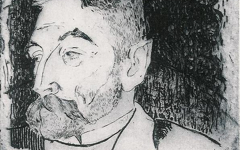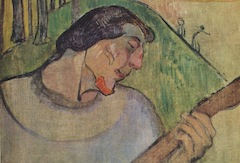Gauguin’s Vision after the Sermon (1888)
Gauguin's strange painting, The Vision after the Sermon, clearly takes place on two levels of reality: that of the women and priest in the foreground who have stopped after the sermon and their vision of Jacob wrestling with the angel in the distance. It has also long been known that the priest, cropped on the far right, has Gauguin's features.
Click next thumbnail to continue

Left: Gauguin's Vision after the Sermon (detail)
Right: Gauguin, Detail of the G of his signature inSelf-Portrait with Halo (1889)
Click image to enlarge.
It has never been noted, though, that the curling strap of the woman’s bonnet in the center resembles the G of Gauguin's own signature. Thus, the women and the priest together, all facing into the canvas as Gauguin would have, are a group alter ego of the artist.
(The example of the G at left is from a painting the next year but a similar shape can be seen on many of his signatures.)
Click next thumbnail to continue

Left: Gauguin, Vision after the Sermon (1888)
Center: Gauguin, Self-portrait after Les Miserables (1888), detail
Right: Diagram of Vision after the Sermon
Click image to enlarge.
The other unrecognized feature is Gauguin's own face. The curving tree trunk represents in exaggerated form his large hooked nose while the leaf on its far side represents his eye. A self-portrait the same year makes his eye leaf-shaped, as in other contemporaneous self-portraits. It was his means of conveying that his vision was at one with nature.
See conclusion below
The new evidence that the women are Gauguin's alter ego, and not just the priest, demonstrates once again that an artist thinks of his mind as androgynous. Meanwhile the discovery that the entire image is a veiled close-up of Gauguin's face confirms that the scene of Jacob wrestling with the Angel takes place inside his mind and supports Mary Gedo's argument that several of the figures including Jacob are substitutes for the artist. She noted, for instance, that both Jacob and the self-portrait on the right wear caps edged with fur.1 The scene is a vision of Gauguin's own inner creative struggle, the theme of a long-standing pictorial tradition in art. (I will soon show how other paintings by Gauguin are composed in a similar manner.) Lastly, since Gauguin urged other artists "to become like God",2 he could easily have thought of the angel and Jacob as two sides of the divinity in his own soul.
For a similar interpretation of the bible story, see the poem Art by Herman Melville (1819-1891). The painting is also the focus of "Gauguin's Method".3
More Works by Gauguin
Notes:
1. Mary Matthews Gedo, ,Looking at Art from the Inside Out: The Psychoiconographic Approach to Modern Art (Cambridge University Press) 1994, pp. 70-6
2. Henri Dorra, The Symbolism of Paul Gauguin: Erotica, Exotica, and the Great Dilemmas of Humanity (University of California Press) 2007, p. 115
3. Abrahams, "Gauguin's Method", blog entry on EPPH (published online 10th November 20110)
Original Publication Date on EPPH: 26 Jan 2011. | Updated: 0. © Simon Abrahams. Articles on this site are the copyright of Simon Abrahams. To use copyrighted material in print or other media for purposes beyond 'fair use', you must obtain permission from the copyright owner. Websites may link to this page without permission (please do) but may not reproduce the material on their own site without crediting Simon Abrahams and EPPH.




